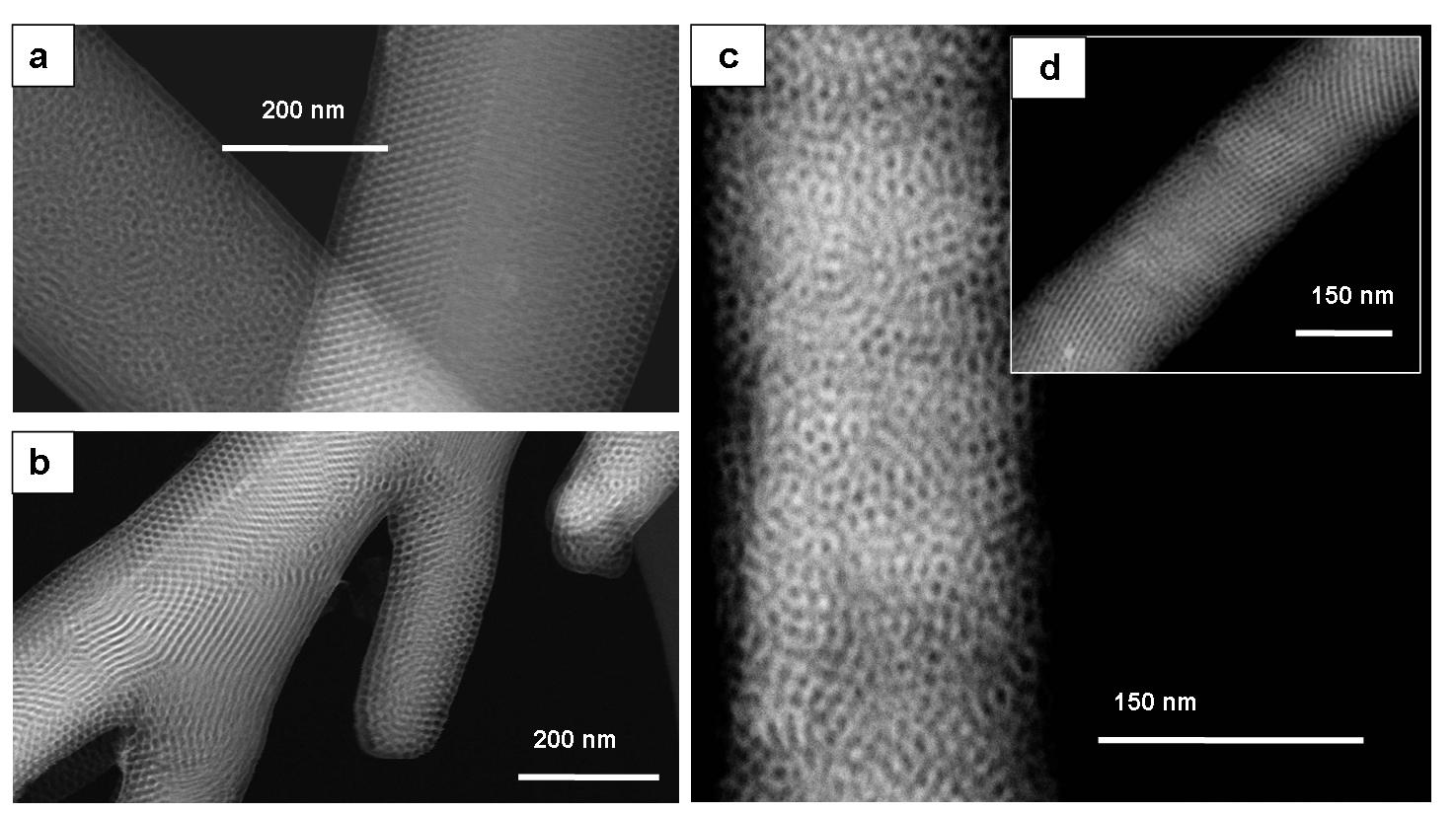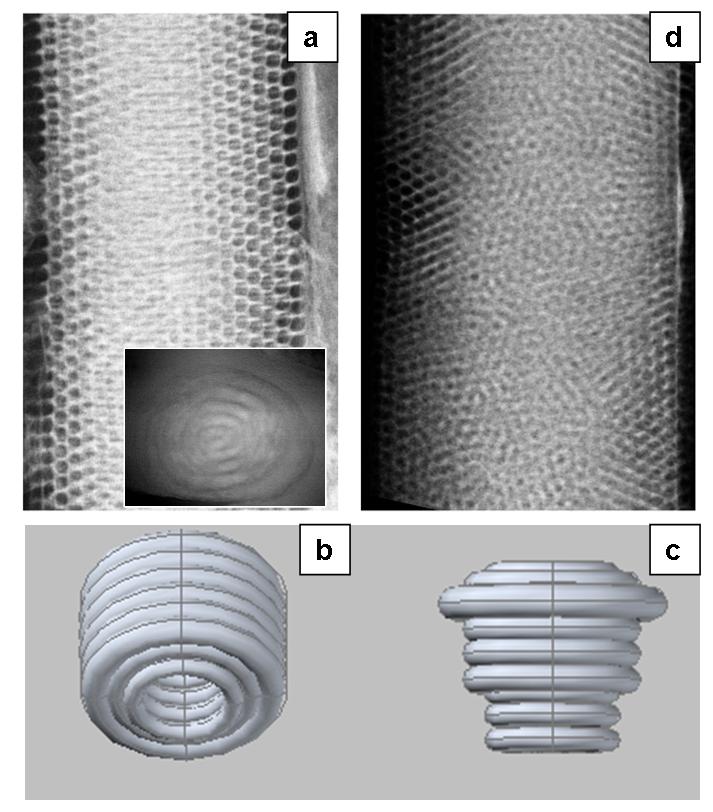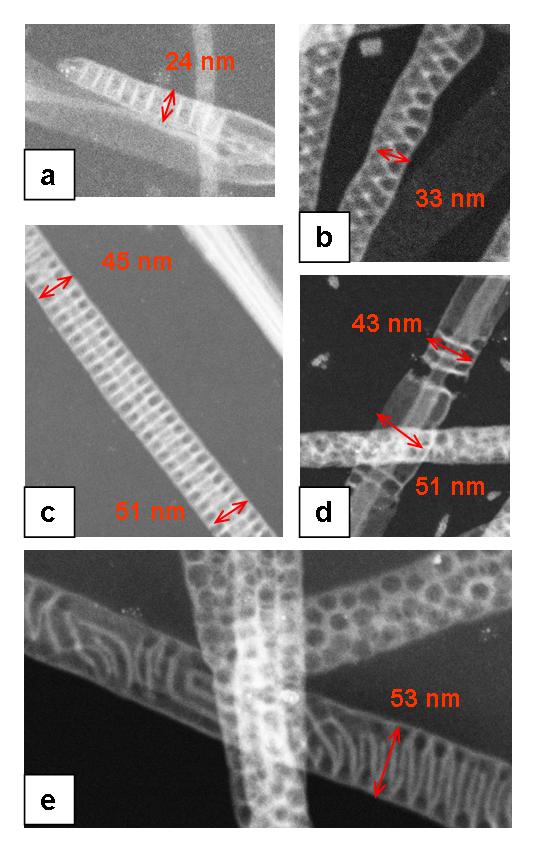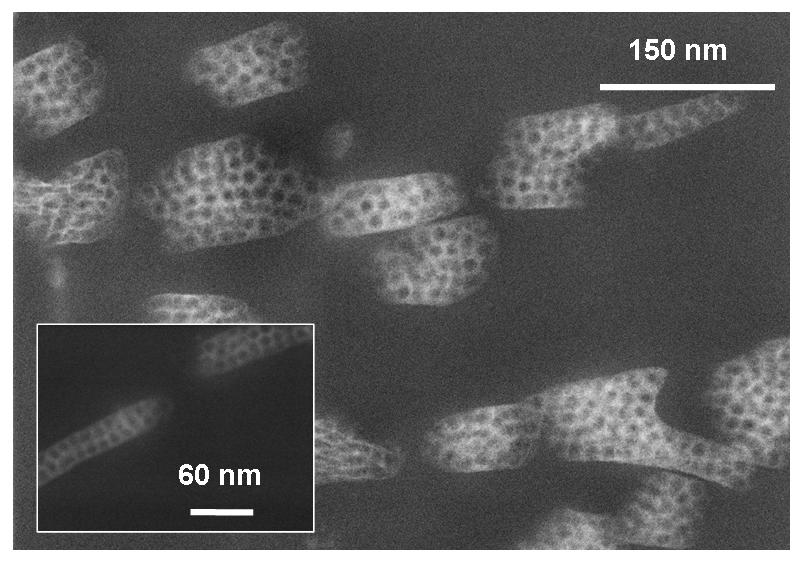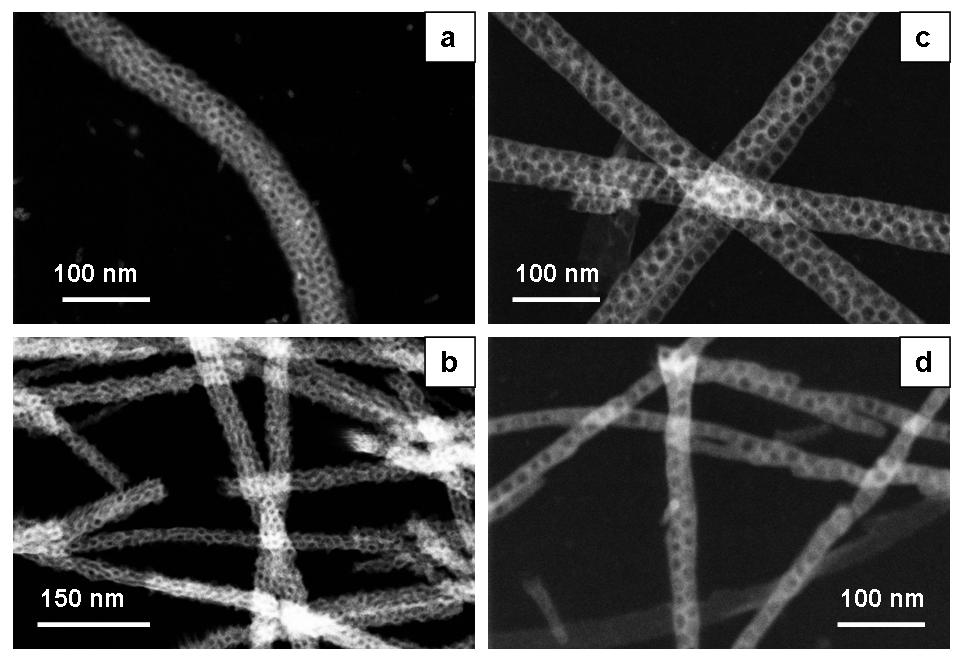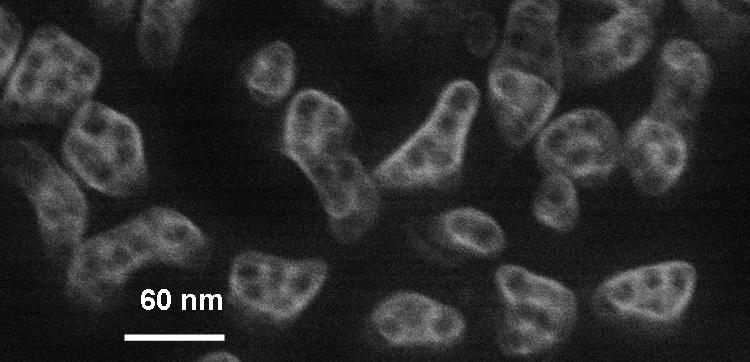1. Introduction
The ordered nanoporous silica materials are of particular interests in both fundamental study of nanostructures and a wide range of applications such as catalysis, adsorption, molecular separation, and a template for producing various types of inorganic nanomaterials [1,2]. Since the discovery of Mobile Crystalline Materials 41 (MCM-41) in 1992 [3], extensive research has been focused on the synthesis of ordered and orientated nanoporous or mesoporous materials via organic-inorganic hybrid self-assembly [4,5,6]. The microphase separation of the block-copolymer guides the nanostructure formation of the inorganic silica by sol-gel reactions in the mesoscale (2-50nm) ordered/patterned hydrophilic microphases. The current studies on ordered nanoporous wires by organic-inorganic hybrid self-assembly have mainly targeted inside space-confined channels of a substrate matrix, including inner channels of relatively large diameters of anodized aluminum oxide membrane (AAO) (120~200 nm) [7,8,9,10,11], a few at smaller diameters of AAO (< 80 nm) [12], and track-etched polycarbonate (EPC) (400 nm) [13]. Substrate channels provide the “hard template” for wire formation and space confinement, while the microphase separation of block-copolymer provides the “soft molecular template” to guide the nanostructure formation within silica wires. The molecular self-assembly phenomena in a space-confined channel could be different from that in bulk. We have previously reported that by relatively large AAO channel confinement, nano-scale columnar orientated straight pores were observed having the long axes of the cylindrical nanopores aligned with AAO channels [14]. In the same substrate, the circular orientated channels were also observed, whose centrically packed donuts aligned with the AAO channels)
[15]. Coiled cylindrical geometry was observed in the smaller AAO channel confinement [15]. By employing relatively large EPC channels of 400 nm, the parallel-packed-channels were produced (as reported in this work). However, the relationships between the substrate characteristics and the structures of silica nanowire have not been established.
In this paper, we report experimental observations of “substrate wall effect” on the ordering and orientation of the intra-wire nanostructure, circular and spiral structure in the AAO substrate, pore-size differences, and the distinctive wire wall morphologies. The effects of substrates, namely AAO and EPC, on the structure and morphology of the silica nanowires are studied by means of scanning and transmission electron microscope (STEM) technique. The underline mechanisms that are responsible for the nanoporous structural ordering and patterns/morphologies inside the silica wires are discussed.
2. Materials and Method
2.1.Materials
TEOS alkoxide, Si(OC2H5)4 was purchased from J. T. Baker Inc. Absolute EtOH (200 proof) was purchased from AAPER Alcohol Chemical Co. HCl aqueous solution with pH of 2.00 was prepared from diluting HCl (6.000 ± 0.030 N) provided by VWR with deionized water. Tri-block poly (ethylene oxide)-poly (propylene oxide)-poly (ethylene oxide) copolymer Pluronic P123 (Mw = 5800, PEO20PPO70PEO20), from BASF Corporation, was used as a self-assembly template due to microphase formation of block-copolymer.
Anodized aluminum oxide (AAO) and track-etched polycarbonate (EPC) were used as channel matrix substrates to space-confine the self-assembly process in silica-P123 hybrid. Various EPCs with an average channel diameter of 200, 80, 50, 30, and 10 nm were the PVP-treated standard white membranes purchased from SPI Supplies. The 200nm-channel AAO was purchased from Whatman Inc. Other various AAO substrates with average channel diameters of 73, 55, 35, and 13 nm were provided by Synkera Technologies Inc.
2.2.Synthesis
Figure 1 schematically shows the space-confined silica-P123 hybrid self-assembly in channels of AAO or EPC discs. As can be seen in this figure, the substrate disc consists of parallel straight nano channels. The diameter of these channels, in the range from 10 nm to 200 nm, is relatively uniform in each substrate matrix. The synthesis procedures of silica-P123 wires involved a series of steps of evaporation-induced self-assembly, sol-gel, and space-confinement inside a substrate channel, as described in our previous report [14,15].
The precursor mixture solutions were prepared as follows: TEOS was pre-hydrolyzed in diluted hydrochloric acid (pH 2) and ethanol solution for about 10 minutes. Tri-block copolymer, P123, which was initially dissolved in ethanol, was added into the acidic TEOS solution. The mixture was stirred for three hours at room temperature (~ 22 °C). The mass ratio of the final precursor solution was kept at (2.6 TEOS): (0.6875 P123): (1.35 HCl solution (pH 2)): (5 EtOH).
The precursor solution was loaded into AAO or EPC channels by vacuum impregnation with substrate disc submerged in the solution for one hour at room temperature. The loaded AAO or EPC membrane was subsequently air dried in ambient condition overnight. To harvest the wires for STEM examination, the substrate materials (AAO or EPC) are removed. Typically, AAO is removed by chemical dissolution method in 5 M HCl at 60 °C for one hour [14]. EPC specimens are generally heat treated in a furnace (60 °C/hr to 550 °C for 5 hr, then 550 °C/hr cooling down) [15] to remove (or burn off) the copolymer template and EPC substrates.
2.3.Characterization
Scanning transmission electron microscopy (STEM, Hitachi 2000), was used to characterize the various harvested nanoporous silica wires. To prepare the appropriate specimen for STEM imaging, free-standing nanowires (after removal of substrate discs) were first dispersed in ethanol using ultrasonication. Then, the suspension of harvested wires was drop-placed on the TEM grids (200 mesh holey carbon film on copper grid) and air dry. When necessary, the cross-sectional view of silica wires was prepared by ultramicrotomed specimen.
3. Results and Discussion
Figure 2 shows the intra-wire structures of nanoporous silica wires formed in both 200 nm AAO and 200 nm EPC. As can be seen in this figure, several distinctive structures are developed including: worm-like structure (Figure 2a (left wire) and Figure 2c), and hexagonal-pattern structure (Figure 2a (right wire)). Parallel lamellar structure [15] is not obviously seen in these images.
It should be noted that the wire surface (tree branch like) morphology is the exact copy of the substrate-channel (Figure 2b), indicating a precise geometric nano-scale confinement. However, as shown in Figure 2a,a highly ordered and oriented structure with an average pore diameter of 10.6 nm is only observed in the large diameter of silica wires from the relatively large channel size “200 nm AAO”. According to Wu et al., a “doughnut” structure could be considered as the rolling-up of 2-D-hexagonal-cylinder-array structure [12]. In this model, the curvature of the AAO channel wall may be responsible for driving the micelles towards the circular orientation [9]. If the “curvature” acts as the driving force, the same circular structure should also be expected in the EPC channels. However, we did not observe such structure in Figure 2c or 2d. Therefore, in addition to the wall curvature, the interaction between the substrate wall and the self-assembly molecules must also play a key role in the formation of the circular structure.
Compared to the packed-hollow-doughnut structure (Figure 3a,a side transmission view of a completely ordered structure with the insert image showing a top view), a “substrate channel wall effect” on the nanophase ordering and orientation was experimentally observed in the nanowires from the “200 nm-AAO” substrate. As can be seen in Figure 3d,the nanopore structure is preferentially more ordered in the vicinity of the channel wall and slightly disordered in the interior of the nanowire. This is likely due to the preferential concentration of block-copolymer P123 in the vicinity of the AAO wall surface, indicating that the initial ordering begins at the wall surface and this effect is reduced towards the interior. Moreover, according to J. Israelachvili [16], even in the absence of any attractive wall-micelle interaction, geometric considerations of the channels alone dictate that the micelle must reorder themselves in order to be accommodated by the substrate walls. Such behavior was also observed in the nanoporous silica thin films [17] and silica nanowires in 200 nm AAO channels by using cetyl trimethylammonium bromide (CTAB) as the self-assembly template [18].
The spiral or circular nanostructure (Figure 4) was only, although a few, observed in silica wires in AAO channels with diameters less than 80 nm. They are parallel rings in 24 nm silica wire (Figure 4a); dual spiral structure in the 33 nm wire (Figure 4b); parallel rings with a cylinder core in wire with diameter from 45 nm to 51 nm (Figure 4c); two-layer concentric cylinder in 51 nm wire (Figure 4d), and mono-spiral nanostructure in 53 nm wire (Figure 4e). Comparison of these structures in Figure 4a and 4c indicates that smaller space-confinement scale (from 51 nm to 45 nm) tends to induce the cylinder core having the diameter between 17 nm and 9.5 nm. However, no such cylinder core was observed as the channel-confinement scale decreased to as small as ~20 nm, nor in the silica wires in EPC.
These observations suggest that the dominating factors affecting the formation of circular and/or spiral nanostructures not only include the curvature of the channel walls but also the surface energy and physical properties of substrate materials.
Besides the spiral structure, packed balloon (Figure 5) is the major structure observed in the silica wires in AAO channels with diameter less than 80 nm. The STEM images of microtomed specimen shows that silica nanowires have a packed balloon structure, where the hollow pores are formed from the burn out of the P123 micelles. P123 has a hexagonal close packed spheres (HCPS) phase, which is in good agreement with the P123/water/ethanol ternary phase diagram reported by S.S. Soni et al. [19].
Pore size is another important morphological difference observed in wires obtained from channels of these two different substrates. The average pore size is 5.8 nm in wires from EPC channels while a much larger wire pore size of 10.6 nm is obtained from AAO channels (Figure 6).
The reported factors contributing to the size of micelle include the block chain length of copolymer and solution composition temperature. For the PEO-PPO tri-block copolymer system, it is known that longer PEO chainleads to smaller pore-size of nanoporous materials [20]. The lattice spacing increases as the weight percentage of P123 decreases [21]. However in this paper, the block chain length and bulk solution composition conditions were kept the same for the formation of silica nanowires in either AAO or EPC channels with size from 10 nm to 200 nm. A possible explanation is that the larger wire pore size from AAO is caused by lower weight percentage of P123 in channels of AAO than that in EPC channels, due to the mass transport differences induced by the substrate-copolymer interaction. In other words, during impregnation of substrate with the TEOS-P123 solution mixture, less copolymer component is transported into the AAO channels than EPC channels.
Furthermore, morphological wise, the wire wall is much smoother for the silica wires obtained from AAO channels than those wires from EPC (Figure 6). The cross-sectional view of the wire in 35 nm-AAO channel (Figure 7) indicates that there appears a thin shell as a continuous solid ring as the “edge” of the wire. Thus it is conjectured that the EPC has a stronger interaction or affinity with P123 than with silica species. In this way, EPC repels silica species accumulating near the EPC channel wall to form a shell. Due to strong affinity between the EPC substrate and P123, the copolymer composition in the TEOS-P123 mixture inside the channels may be richer than in the bulk solution (outside the channels). The higher P123 concentration in the channel is the reason for the smaller pore size is consistent with previous discussions [22].
4. Conclusions
Nanoporous silica wires of different diameters were synthesized by using P123 as a molecular self-assembly template and parallel channels in substrate AAO or EPC as space-confinement approach. The shape of the wires was confined by the channel diameter and follows the geometry of the substrate channels. The material difference and characteristics of substrates play significant roles in the ordering and morphology of the intra-wire mesoporous nanostructures. For instance, the circular and spiral structures were only observed in wires formed in AAO channels, but not in EPC channels. Meanwhile both pore-size and wire morphology were also significantly affected by the substrate difference. The effects of the substrate channel structure, as well as the interaction between the substrate channel wall and wire morphology were investigated. The mesopore structures in wires are determined by the process condition parameters and substrate properties.
Acknowledgment
This work was supported by the Division of Materials Science (KC 02 03 01 0), Office of Science, the U.S. Department of Energy and also sponsored in part by the Assistant Secretary for Energy Efficiency and Renewable Energy, Office of Transportation Technologies, as part of the High Temperature Materials Laboratory, managed by UT-Battelle, LLC, for the U.S. Department of Energy under contract DE-AC05-00OR22725; and partially sponsored by the Bioenergy Technologies Office for preparing the manuscript. Peng Lai was sponsored to work at ORNL through an ORAU postmaster internship program. Thanks are given to Donglu Shi (Peng Lai’s former Master thesis advisor at University of Cincinnati) and Douglas Blom for assisting the STEM operation at the former HTML facility. Thanks are also given to Synkera Technologies Inc. for providing sample AAO discs.
Conflict of Interests
The authors declare that there is no conflict of interests regarding the publication of this paper.









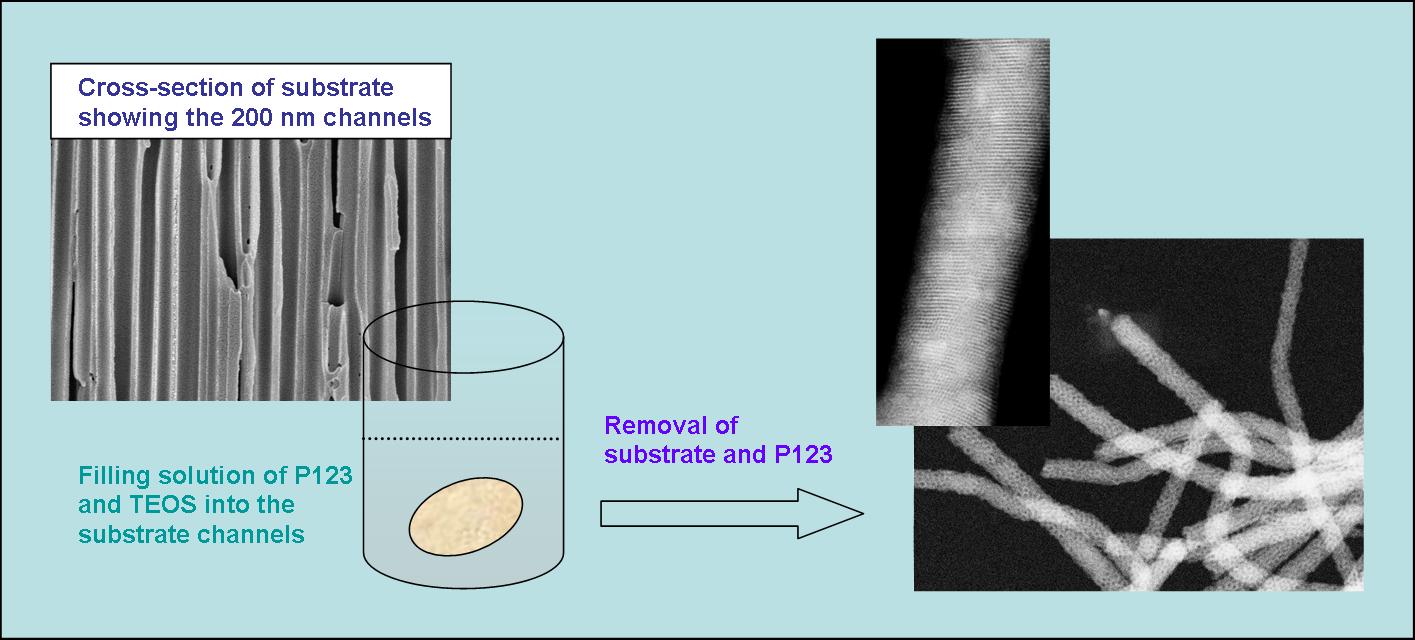
 DownLoad:
DownLoad: 